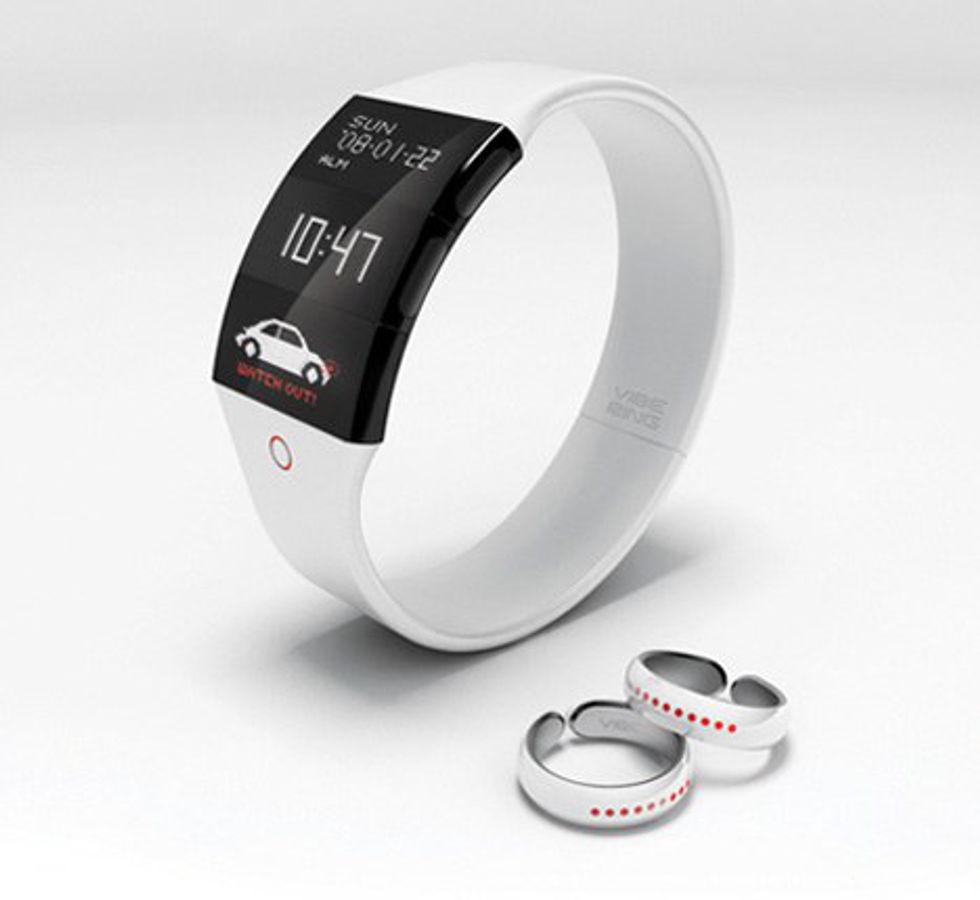Creative ideas inspire the way we think about the world around us. They help to spark new ways of thinking and exploration of the innovative world. Not always are products about creating a net profit. Sometimes the most creative products have a larger focus: helping others. Whether it is making day-to-day travel safer for others or creating eco-friendly alternatives that solve world-wide issues, innovation allows for people to create creative solutions to make a tremendous impact.
Viberring
Imagine a car turning the corner of a busy street. You're walking and - without noticing - a car pulls up besides you. With Viberring by Yanko Design, creators Kwang-seok Jeong, Min-hee kim, and Hyun-joong Kim are making it possible for unaware deaf users to 'listen' for approaching dangers without being able to hear them. This uniquely designed wristwatch and ring set combine wireless technology to provided users with a safe way to travel their neighborhoods freely. The set contains a sound detection and identification system that helps the deaf and hard of hearing to capture sounds around them. With one ring worn on both hands, the rings act as the users ears, collecting sound and listening for potential dangers behind the individual. This information is then presents on an easy to read display screen, providing the user with an estimate distance of the noise. Not only is this device able to pick up noises behind and in front of the individual, but it is capable of identifying key phrases that would occur between human interactions such as someone calling out a name or saying "Excuse me...". The device is also able to identify car noises, including car horns, eliminating potential hazards.
Bakeys
Mountains of plastic cutlery fill landfills in India - around 120 billion pieces of disposable cutlery. Narayan Peesapaty, a researcher and agriculture consultant in Hyderabad, India has a solution. Made of millet, rice, and wheat flours, these edible miracle will prevent thousands of pounds of plastic from being tossed into the 'never-ending' landfills. The durable delicacy can last 20 minutes in hot water, making it possible to use at any meal. In the flavors of sugar, ginger-cinnamon, ginger-garlic, cumin, celery, black pepper, mint-ginger, and carrot beet-root, this biodegradable substitute has a shelf life of two to three years. Don't feel like eating? It's okay! Each spoon will decompose in four to five days, making disposable easy and non-costly.
Bakeys isn't the only company with this in mind. Edible Spoon Maker also creates similar edible utensils using any dough a customer wishes. Unlike the Edible Spoon Maker 'do-it-yourself product', Narayan has bigger plans for his concept. Hoping to reach a broader audience Narayan released a kickstarter campaign where he hoped to raise $20,000 and - in nine days of his month-long crowdfunding - raised over $64,000. He soon hopes to create new molds to produce an even wider variety of utensils that adapt to cultural regions and other activities such as chopsticks, dessert spoons, and forks. He eventually hopes to expands business into cups, plates, and other traditional tableware, converting the paper-plastic world into a much safer and environmentally friendly solution.
Paving A Path To The Future
A bright yellow light warms the road way warning drivers of a moose that has just entered the roadway. With color-changing roadways, drivers are able to avoid possible accidents as they are pre-warned of upcoming problems and potential hazards. This is the future of our roadways. Designed by engineering couple Scott and Julia Bradshaw, this solar roadway project attempts to create a safer and more energy-efficient solution to 'clean driving'. Tripling the USA's energy production, these solar saviors will not only save lives, but will provide individuals with greener solutions to transportation, increasing the production of electric cars and providing homes with clean and abundant energy. With the production of such a wide scale project, not only would an influx of job opportunities be open on the market, but it would eliminate the need for dangerous telephone wires that cause power outages, non storm-safe wires, and are hit by distracted drivers. With no gasoline costs, increases in jobs, lowered taxes, no need for salt on the road, and no repaving required, this technology-driven solution could change the way Americans live their day-to-day lives. According to the paving department of Ohio, it costs $120,000 per lane mile for 2 lane roads. Imagine the money that could be saved by only needing to replace a single panel! With support from the U.S. Department of Transportation, these prototypes may soon be a reality.




















